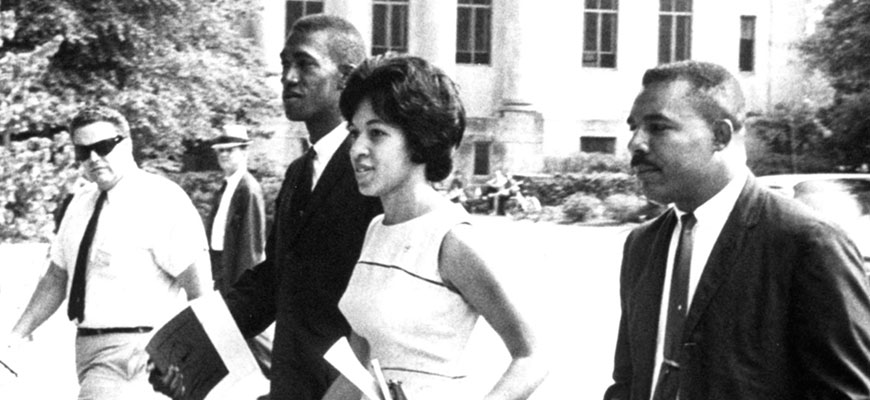
UofSC to commemorate 3 students who desegregated the university
Statues on Columbia campus to honor bravery of Anderson, Treadwell and Solomon
Posted on: February 17, 2022; Updated on: February 17, 2022
By Jeff Stensland, stenslan@mailbox.sc.edu, 803-777-3686
The University of South Carolina will honor the three Black students who desegregated the school in 1963 with statues on the Columbia campus commemorating the historic day when they enrolled and became the first Black university students since the Reconstruction era, paving the way for generations of future scholars.
The university’s Board of Trustees voted on Friday (Feb. 18) to erect the statues celebrating Robert G. Anderson, Henrie Monteith Treadwell and James L. Solomon Jr. The statues will portray the three students as they took their historic walk from the Osborne Administration building to the Naval Armory, now Hamilton College, where they first registered for classes on the morning of Sept. 11, 1963.
“The University of South Carolina has a long and complex history. The action today celebrates the achievements—and the tremendous courage—of those who fought to make the university a place where all South Carolinians are welcomed,” said Board Chair C. Dorn Smith, III M.D.
The enrollment of Anderson, Treadwell and Solomon came three years after the U.S. Supreme Court’s historic Brown v. Board of Education ruling and followed violent unrest at other Southern campuses that had already desegrated. The university planned for months to ensure the three students’ enrollment at South Carolina would be peaceful. Their registration process was captured by national media and lasted only about 20 minutes, but the significance of the 1963 event reverberates to this day, said Board of Trustee member Alex English.
“My enrollment at the university less than a decade later would not have been possible if not for the bravery of these three students,” English said. “Our university continues to make great strides, but our work to ensure greater inclusivity is not done. I hope these statues serve both to educate and inspire others to continue to break barriers.”
Anderson died in 2009, but Treadwell and Solomon returned to the university in 2014 to help commemorate the 50th anniversary of their enrollment and to dedicate the campus’ Desegregation Garden near the historic Horseshoe.
“The grace, maturity and resolve exhibited by those three young students, then and in the years since, cannot be overstated,” Interim President Harris Pastides said. “They carried the weight of history on their shoulders on that momentous day in 1963. They lived up to expectations beyond their years, withstood the hostility of those who opposed desegregation, and continued to represent the highest ideals of a just society. This lasting memorial on our campus will be a fitting tribute.”
The university will soon begin a process of selecting a sculptor to develop the project, followed by a final project approval by the Board. The statues are expected to be unveiled in the fall of 2023.
Friday’s vote follows a series of steps by the university to tell the story of its history and to honor those who deserve greater recognition. In January, the university announced the naming of a residence hall after education pioneer and South Carolina College alumna Celia Dial Saxon. The statue of Anderson, Treadwell and Solomon will be only the fourth statue on the university’s campus honoring individuals. Other statues include Richard T. Greener, the school’s first African American professor, Gamecock football great George Rogers and women’s basketball star A’ja Wilson.
About the Three
Robert G. Anderson
Robert G. Anderson, a native of Greenville, began his college career at Clark College in Atlanta. In 1963, he became part of the desegregation struggle at the University of South Carolina as a transfer student.
Anderson’s life and career became a testament to public service. He served a combat tour in Vietnam and later served as a social worker in New York City for many years. He earned a professional social work degree from Hunter College. He helped Cuban refugees, worked with mothers and children in the Bureau of Child Welfare and ran an alcohol counseling program. After retirement from social work Anderson worked in the Veterans Administration for 12 years. He died in 2009.
Henrie Monteith Treadwell
In 1965, Treadwell became the first black student to graduate from the university since 1877, earning a bachelor’s degree in biochemistry. She continued her education at Atlanta University, earning a master’s and doctorate in biochemistry. She completed post-doctoral studies in public health at Harvard University.
Treadwell, a native of Columbia, SC, later became the director of Community Voices at Morehouse School of Medicine where she studied healthcare for underserved populations and researched the health concerns of teenage African American males, including prison health, health policy and health services.
James L. Solomon Jr.
Prior to enrolling in graduate school at the University of South Carolina 1963, James L. Solomon Jr., a native of McDonough, Ga., served in the U.S. Air Force for six years; attended Morris College, where he received a bachelor’s degree in chemistry; attended Atlanta University, where he received a master’s degree in mathematics; and served as an administrator at Morris College for three years.
Solomon served in various state government positions including division director at the Commission on Higher Education and the commissioner of the Department of Social Services (DSS). In Columbia, he served on various boards and councils, including Brothers and Sisters, Columbia Urban League, Richland 1 School District, where he was the first African American to serve as chairman, Richland County Council, South Carolina Commission on the Future and the United Way of the Midlands.
Share this Story! Let friends in your social network know what you are reading about